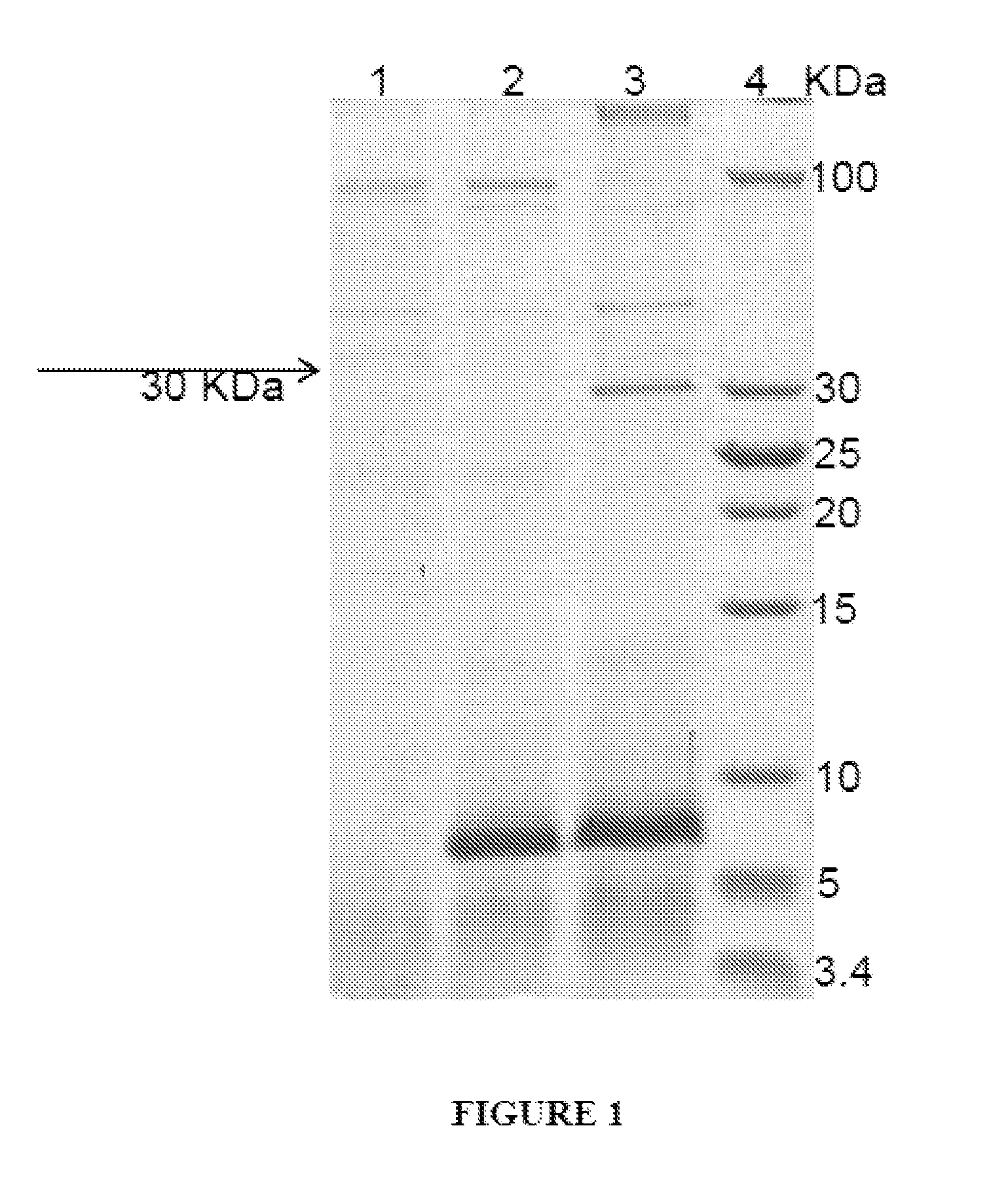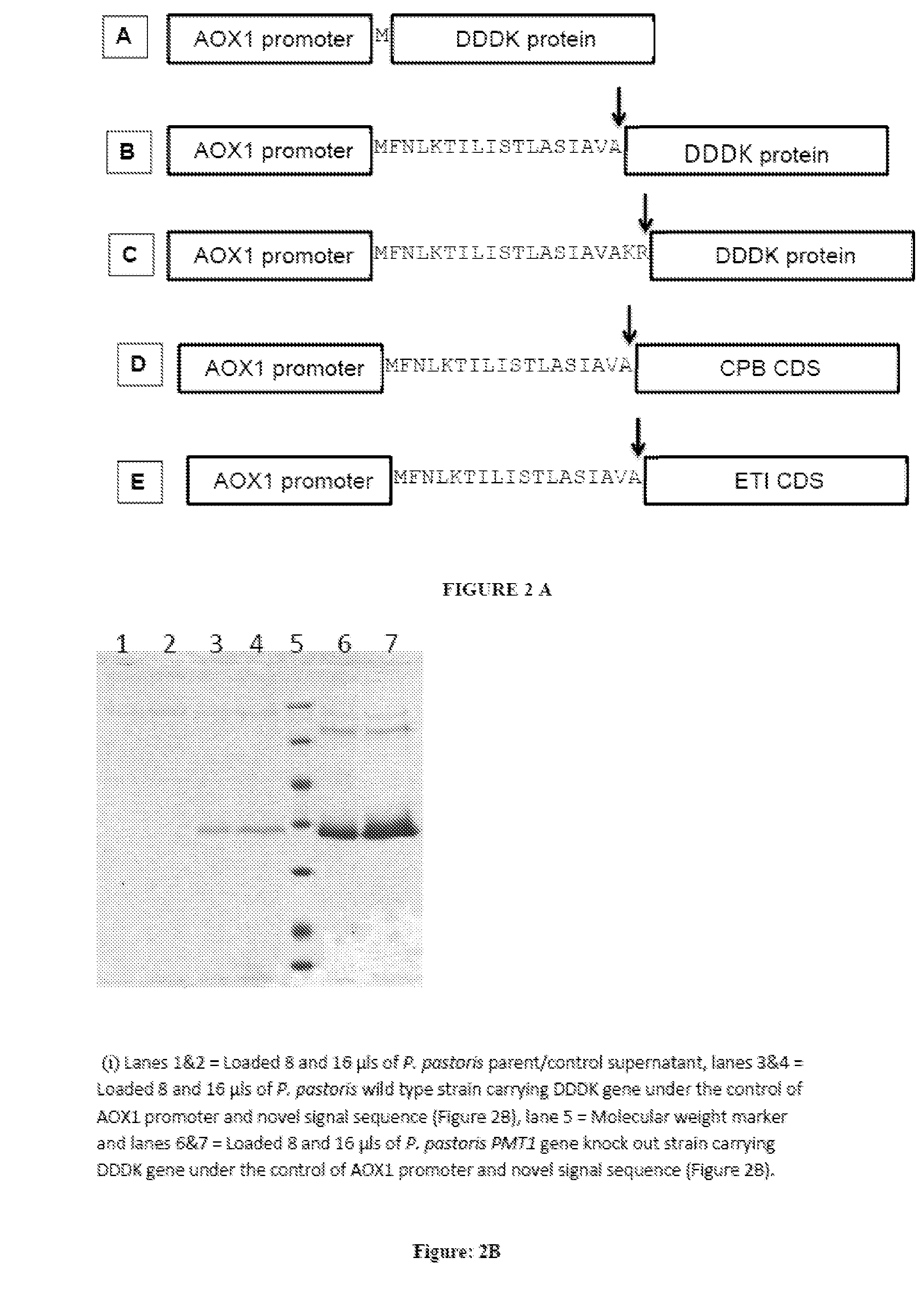Signal sequence for protein expression in pichia pastoris
a technology of signal sequence and protein, applied in the field of signal sequence for protein expression in pichia pastoris, can solve the problems of amino acids and region that cannot be expressed using this signal sequen
- Summary
- Abstract
- Description
- Claims
- Application Information
AI Technical Summary
Benefits of technology
Problems solved by technology
Method used
Image
Examples
experimental examples
Example 1
[0061]Construction of the Expression Constructs for Secretory Expression in P. pastoris
[0062]The gene corresponding to the DDDK protein (SEQ ID NO: 4) was amplified along with signal sequence using primers DDKFP (SEQ ID NO: 6) and DDKRP (SEQ ID NO: 7) (FIG. 7) and P. pastoris genomic DNA template. The 870 bps PCR product was cloned into pTZ57R vector, sequence verified. The gene excised using BamHI and EcoRI sites and subcloned into pMBLNSS208 vector in BamHI and EcoRI restriction sites to obtain DDK / pMBLNSS208 vector which replaces the Matα signal sequence. The DDDK gene is under the regulatory control of AOX1 promoter (SEQ ID NO: 19) (FIG. 2B). The DDDK protein ORF without the signal sequence (SEQ ID NO: 5) was amplified and cloned similarly to have a control for the above (FIG. 2A). The forward primer used was DDK(-SS)FP (SEQ ID NO: 8) in place of DDKFP. These two constructs were used to study whether the strong promoter can lead to secretion of this protein in the wild...
example 2
[0063]Synthesis of Signal Sequence and Development of CPB and ETI Clones
[0064]The signal sequence was synthesized using the primers NSSFP1 (SEQ ID NO: 10), NSSFP2 (SEQ ID NO: 11), NSSFP3 (SEQ ID NO: 12), NSSRP1 (SEQ ID NO: 13), NSSRP2 (SEQ ID NO: 14) and NSSRP3 (SEQ ID NO: 15) (FIG. 7). The primers were phosphorylated by treating with T4 polynucleotide kinase, annealed and ligated. The full length signal sequence was amplified from the ligated template using NSSFP1 (SEQ ID NO: 10) and NSSRP1 (SEQ ID NO: 13). The PCR product was cloned into pTZ57R vector and sequence verified. The signal sequence was cloned into pMBL208 vector to replace the Matα signal sequence.
[0065]The CPB codsing sequence (SEQ ID NO: 20) and the ETI coding sequence (SEQ ID NO: 24) were amplified using the forward primers NSSVACPB (SEQ ID NO: 16) and NSSVAETI (SEQ ID NO: 17) and pPIC9K reverse primer (SEQ ID NO: 18) from the plasmid CPB / pPIC9K and ETI / pPIC9K which were expressed previously in our laboratory. The f...
example 3
[0066]Transformation of Pichia pastoris
[0067]The plasmids constructs were digested with SacI and transformed into P. pastoris (his−) strain. Transformation was carried out by electroporation of freshly prepared competent cells in 0.2 cm cuvettes. The pulses were delivered by Gene Pulser (BioRad) at 1500 V, 25 μF, and 200 Ω. The electroporated cells were allowed to recover for 1 hour in 1M Sorbitol at 30° C. and then spread on to YNBD agar plates. The resulting transformants were selected on YPD plates, containing 0.5 mg / ml of G418 concentrations to identify multicopy clones. Several clones that were viable at 0.5 mg / ml concentration were tested in small scale induction experiments. The proteins secreted to the extracellular medium were analyzed on 10% SDS-PAGE.
PUM
| Property | Measurement | Unit |
|---|---|---|
| concentrations | aaaaa | aaaaa |
| concentration | aaaaa | aaaaa |
| pH | aaaaa | aaaaa |
Abstract
Description
Claims
Application Information
 Login to View More
Login to View More - R&D
- Intellectual Property
- Life Sciences
- Materials
- Tech Scout
- Unparalleled Data Quality
- Higher Quality Content
- 60% Fewer Hallucinations
Browse by: Latest US Patents, China's latest patents, Technical Efficacy Thesaurus, Application Domain, Technology Topic, Popular Technical Reports.
© 2025 PatSnap. All rights reserved.Legal|Privacy policy|Modern Slavery Act Transparency Statement|Sitemap|About US| Contact US: help@patsnap.com



